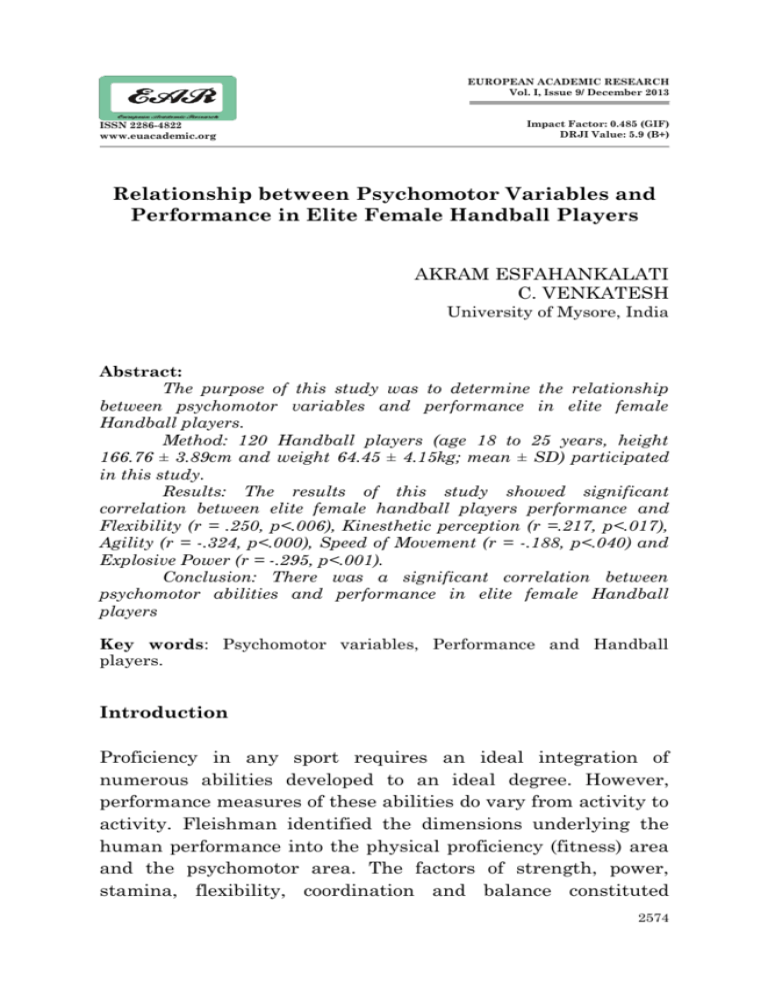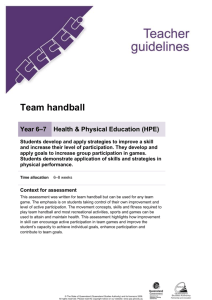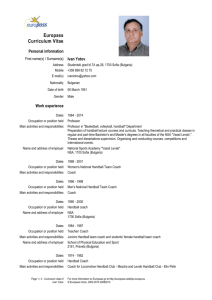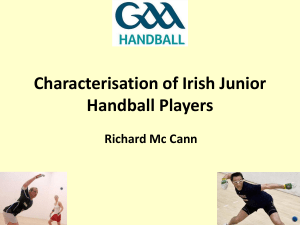EUROPEAN ACADEMIC RESEARCH, VOL
advertisement

EUROPEAN ACADEMIC RESEARCH Vol. I, Issue 9/ December 2013 ISSN 2286-4822 www.euacademic.org Impact Factor: 0.485 (GIF) DRJI Value: 5.9 (B+) Relationship between Psychomotor Variables and Performance in Elite Female Handball Players AKRAM ESFAHANKALATI C. VENKATESH University of Mysore, India Abstract: The purpose of this study was to determine the relationship between psychomotor variables and performance in elite female Handball players. Method: 120 Handball players (age 18 to 25 years, height 166.76 ± 3.89cm and weight 64.45 ± 4.15kg; mean ± SD) participated in this study. Results: The results of this study showed significant correlation between elite female handball players performance and Flexibility (r = .250, p<.006), Kinesthetic perception (r =.217, p<.017), Agility (r = -.324, p<.000), Speed of Movement (r = -.188, p<.040) and Explosive Power (r = -.295, p<.001). Conclusion: There was a significant correlation between psychomotor abilities and performance in elite female Handball players Key words: Psychomotor variables, Performance and Handball players. Introduction Proficiency in any sport requires an ideal integration of numerous abilities developed to an ideal degree. However, performance measures of these abilities do vary from activity to activity. Fleishman identified the dimensions underlying the human performance into the physical proficiency (fitness) area and the psychomotor area. The factors of strength, power, stamina, flexibility, coordination and balance constituted 2574 Akram Esfahankalati, C. Venkatesh- Relationship between Psychomotor Variables and Performance in Elite Female Handball Players proficiency whereas reaction-time, speed of movement, armhand steadiness, visual perception, manual dexterity and rate control were the abilities considered under psychomotor domain. (3) Psychomotor variables act as the medium for the realization of cognitive and affective domains of learning and motor behavior. All these domains of learning are inseparable identities and work in perfect harmony and unison with one another. The psychomotor variables are primarily concerned with muscular contraction. Performance of motor skills involves neural, physiological and psychological aspects and is a continuum that runs the gamut from physical to cognitive and there is always integration between these aspects of human behavior. (11) Psychomotor fitness of an individual is a perfect blending of physical as well as motor fitness and goes a long way in fielding the excellent outcomes. The nations exhibiting excellence in the international sports do attach great significance to the total fitness level of their players. Different sports activities call for different levels of fitness. The level of fitness varies depending upon the level of competition as well. Participation in the top-notch competitive Handball requires the player to be in a state of optimum fitness. Modern Handball is a fast game, characterized by incredible athletic performances by athletes. In fact, modern Handball players are able to perform many different moves, jumps, running, change of directions and technical movements in very short time and with an order determined by the tactical situation. Running with and without the ball; in line and with different paths; jumping; throwing and passing and receiving in motion or during flight represent the technical characteristics of modern top Handball players. Then, to excel at the highest levels, it is important that training methodologies are developed on a simple basis: specificity. The closer to the demands of the performance, the better the training is. Of EUROPEAN ACADEMIC RESEARCH - Vol. I, Issue 9 / December 2013 2575 Akram Esfahankalati, C. Venkatesh- Relationship between Psychomotor Variables and Performance in Elite Female Handball Players course, to obey to the law of specificity we have to know exactly what are the physiological demands of handball performance. Unfortunately, in sport science literature, very few works have been presented in which a deep analysis of Handball performance has been conducted. )4) Therefore the aim of this work was to find out the relationship between psychomotor variables and performance in elite female Handball players. Methods Subjects The subjects selected for this research were 120 elite female handball players aged between 18 to 25 years old, which play at national primer and super leagues, in Iran. The subjects were selected randomly. All athletes had been training regularly 4-5 days per week and having at least 5 years playing experiences in handball. Psychomotor Variables Assessment Explosive Power Jump and Reach or vertical jump test: This test is used to measure the explosive power of the legs. The subject stood with her side toward the wall with heels together on the floor. From this position, her standing reach was marked by making her reach as high as possible with heels completely intact with the floor and make a mark on the wall with the chalked tip of the finger. The subject then swang her arms forward and backward, took a crouched position with the knees bent at about right angle and leapt as high and quickly as possible with the upward swinging action of her arms and straightening of her legs. During the course of this explosive act, the subject made another mark on the wall with the same chalked finger at the highest point of her jump reach above the initial one made EUROPEAN ACADEMIC RESEARCH - Vol. I, Issue 9 / December 2013 2576 Akram Esfahankalati, C. Venkatesh- Relationship between Psychomotor Variables and Performance in Elite Female Handball Players while in the state position. Each subject was given three consecutive trials and the best of this jump and reach was considered as the final score of the subject. The distance between her standing reach and the jumped reach was recorded to the nearest centimeters as the score of the subject. Speed of Movement Nelson Speed of Movement Test: The objective was to measure combined reaction and Speed of Movement of hands and the arms. The performer sat on the table with her hands resting on the edge of the table, palms facing each other with the inside of the little fingers 30 cm apart and first in lines marked on the table. The tester held the timer i.e., wooden meter scale near its top and it hung right midway between the subject’s palms with the base line of the timer positioned evenly with the upper edges of the subjects index fingers. After the preparatory command ready was given, the timer was dropped and the subject attempted with a horizontal movement and stopped it as quickly as possible by clapping the hands together. The score for the combined response movement was read from the timer at the point just above the upper edge of the hand after the catch was made. Twenty trials were given in all too every one of the subjects. The 5 slowest and the 5 fastest trials were discarded and an average of the middle ten – trial was recorded as the subject's score. Agility SEMO-Agility Test: This test is used to determine the general agility of the body in maneuvering forward, backward and sideward movements. The cones were placed squarely. The subject was made to stand at the starting point with her back to the marked area. The subject on receiving signal 'ready-go' from the tester moves side-stepped from 'A' to 'B' and passed outside the corner cone at 'B'. Then from 'B' to 'D', the subject backpedaled and passed to the inner side of the corner cone at 'D'. EUROPEAN ACADEMIC RESEARCH - Vol. I, Issue 9 / December 2013 2577 Akram Esfahankalati, C. Venkatesh- Relationship between Psychomotor Variables and Performance in Elite Female Handball Players The subject then sprinted from 'D' to 'A' and after passing outside the corner cone at 'A', back pedaled the distance from 'A' to 'C' and passed inside of the corner cone at 'C'. The subject sprinted the distance between 'C' and 'B' and side-stepped the distance from 'B' to 'A' thereby reaching the finishing point. The best time of the two trials (to the nearest 0.01 of a second) was recorded as the score of the subject. Kinesthetic Perception Horizontal Space Test (Test of Horizontal Distance): The objective was to measure the Kinesthetic Perception ability to determine specific positions along the horizontal line. The yard stick was placed on the wall so that it was approximately at eye level while the subject was in the sitting position. The subject was asked to sit in the chair facing the yard stick and attempted to establish in her mind a sense of its position. Then while blindfolded and without a practice trial she pointed the index finger of her right hand to the point indicated by the tester. The score was the deviation from the desired mark measured to the nearest centimeter. The final score was the total of the deviations on 3 trials. Flexibility Upward- Backward Movement of Arms Test: This test is used to measure the flexibility of the shoulder and shoulder girdles. The subjects lay in a prone position on a mat with their chin touching the mat and arms reaching forward directly in front of her shoulders. They held the stick horizontally with both the hands keeping elbows and wrists straight and chin on the mat; she raised arms upward and backward as far as possible. The vertical distance from the bottom of the stick to the mat was recorded in centimeters as the measure as flexibility of the shoulder and shoulder girdles. EUROPEAN ACADEMIC RESEARCH - Vol. I, Issue 9 / December 2013 2578 Akram Esfahankalati, C. Venkatesh- Relationship between Psychomotor Variables and Performance in Elite Female Handball Players Performance assessment The Handball playing ability of the subjects was assessed by the application of a Handball Rating Scale. Handball performance (rating scale) was prepared by a panel of experts comprising two experienced Handball coaches and a very Senior National Level Handball player. With the help of this Rating Scale, the researcher enabled herself to assigning a numerical (quantitative) value to the subjective (qualitative) judgment of the experts. Handball Rating Scale was used to measure the overall playing ability of subjects through the subjective evaluation of the experts in the field of Handball. Description Handball Rating Scale: Each of the seven components of Handball playing ability, namely : 1- Passing, 2-Dribbling, 3- Shooting Penalty, 4Shooting 9m, 5- Defense, 6-Offence has scored based on Table 1. For overall game was scored on 10 to 1 also. 5 points Exceptional ability, near perfect 4 points 3 points 2 points Above average ability, not perfect, but quite skillful Average ability, typical Below average ability, characterized by more mistakes than was typical Inferior ability, far below typical performance 1 point Table 1: Rating scale for assessment of performance in handball player Protocol The study was conducted according to the ethical principles for clinical research involving human subjects in accordance to the Declaration of Helsinki and all data were collected in the forenoon (8 to 12 am). Statistics The descriptive statistics was used for description of data and means (M) and standard deviations (SD) were calculated. EUROPEAN ACADEMIC RESEARCH - Vol. I, Issue 9 / December 2013 2579 Akram Esfahankalati, C. Venkatesh- Relationship between Psychomotor Variables and Performance in Elite Female Handball Players Pearson correlation test was used for relationship of psychomotor abilities and performance. Analyses were carried out using SPSS v18.0 (SPSS, 2009). Significance was set at p<0.05 for all tests. Results Results of Descriptive analysis of psychomotor variables in Handball players were showed in Table 2. Mean and standard deviation of Flexibility 29.66 ± 7.57, kinesthetic perception 5.18 ± 2.97, Agility 13.97 ± 1.34, Speed of Movement 14.57 ± 3.55 and Explosive Power 30.69 ± 6.43 were obtained. Variables N Mean Std. Deviation Std. Error Flexibility 120 29.66 7.57 0.69 Kinesthetic perception 120 5.18 2.97 0.27 Agility 120 13.97 1.34 0.12 Speed of Movement 120 14.57 3.55 0.32 Explosive Power 120 30.69 6.43 0.59 Table 2: Descriptive analysis of psychomotor variables Figure 1: psychomotor variables in elite female handball players Result of Descriptive analysis of performance in Handball players was showed in Table 3. Mean and standard deviation of Performance in Handball players 32.61 ± 4.2 was showed. EUROPEAN ACADEMIC RESEARCH - Vol. I, Issue 9 / December 2013 2580 Akram Esfahankalati, C. Venkatesh- Relationship between Psychomotor Variables and Performance in Elite Female Handball Players Variable N Mean Std. Deviation Std. Error Performance 120 32.61 4.20 0.38 Table 3: Descriptive analysis of performance Correlation Coefficients between psychomotor variables and performance Significant correlations were detected between psychomotor variables and performance (Table 4). The results of this study showed significant correlation between elite female handball players performance and Flexibility (r = .250, p<.006), Kinesthetic perception (r =.217, p<.017), Agility (r = -.324, p<.000), Speed of Movement (r = -.188, p<.040) and Explosive Power (r = -.295, p<.001). Variables Performance N Pearson Correlation Sig. (2-tailed) Flexibility Kinesthetic perception Agility Speed of Movement Explosive Power 120 120 120 120 120 .006 .017 .000 .040 .001 .250(**) .217(*) -.324(**) -.188(*) -.295(**) Table 4: Correlation Coefficients between psychomotor variables and Performance * Correlation is significant at the 0.05 level (2-tailed) ** Correlation is significant at the 0.01 level (2-tailed) Discussion The analysis of sports training in recent times has brought into focus the role of the social scientists, physiologists, psychologists and sports medicine specialists. It is important to understand the role of different sportive factors that influence performance in combination and individually. This will help the coach or a physical educationist to council the potential of talented sportsmen at an appropriate age. EUROPEAN ACADEMIC RESEARCH - Vol. I, Issue 9 / December 2013 2581 Akram Esfahankalati, C. Venkatesh- Relationship between Psychomotor Variables and Performance in Elite Female Handball Players The results of this study showed a significant correlation between elite female handball players' performance and Flexibility, Kinesthetic perception, Agility, Speed of Movement and Explosive Power. Statistically highly negative significant correlation was found between explosive power and performance (r = -.295, p<.001). Several similar findings were also observed by Edward S. Steiz, Mourad et.al, Barker and Shondell. (5, 9, 2, 12) No handball player can be successful in the game unless she possesses a good amount of explosive power. Explosive power is very important to shoot successfully, to jump as high as possible above the defenders', and defend successfully. So, it is very important that explosive power be a huge part of training, because it’s not only a way to help develop absolute strength but also a way of elevating physical fitness that leads to a sport specific task. Statistically negative significant correlation was found between Speed of movement and performance (r = -.188, p<.040). Several similar findings were also observed by Katic et al. and Toyoda. (8, 13) Speed of movement helps players for preparatory selfmotivation and also referred to once general state of health as speed also indicates reaction which refers to movement and quickness of player in Handball for playing their different skills such as shooting, holing, dribbling and throwing the Ball. Every player of Handball require better speed work and early reaction of the players in different game situations with the speed of movement player that can make good running in the Handball court and also bring him to move quickly to follow the Ball and can more in different corner of the count to play in a correct way with perfect timings. Statistically highly negative significant correlation was found between Agility and performance (r = -.324, p<.000). Several similar findings were also observed by Anil and Waghmare, Katic, et.al and Toyoda. (1, 8, 13) But Ikeda and EUROPEAN ACADEMIC RESEARCH - Vol. I, Issue 9 / December 2013 2582 Akram Esfahankalati, C. Venkatesh- Relationship between Psychomotor Variables and Performance in Elite Female Handball Players Joseph did not found a significant relationship between the Agility and playing ability. (6, 7) Agility represents one of the most complex motor abilities. Most coaches believe that the different motor characteristics represent the "foundation" of agility or change in the speed/direction of motion. Rooney (2005) indicates the following motor characteristics as the basis of agility: relative strength (compared to the athletes body mass), linear speed, motor coordination (timing), balance (stability) and motor programs (technique). (8) Statistically positive significant correlation was found between Kinesthetic Perception and performance (r =.217, p<.017). A finding of Ikeda showed there is no significant relationship between kinesthetic and performance. (6) Statistically highly positive significant correlation was found between Flexibility and performance (r = .250, p<.006). Ikeda and Joseph did not find a significant relationship between the flexibility and playing ability. (6, 7) Psychomotor variables -especially agility and flexibilityare the basic requirement as well as foundation basis in every fundamental of the Handball game. We require power of wrist, shoulders movement of leg muscular strength, upper and lower extremities in an action to make power and speed of movement. This is a coordination of all the parameters of motor ability used in different playing situations of Handball. For successful performance of various skills involved in the game of handball, a player must be able to maintain both static well as dynamic balance during the course of play. A handball player, when in position, has to be stable so as to receive the ball from dribble, pass and shot but at the same time she should be able to move into either direction as quickly as possible. A handball player should therefore be well familiar with all principles of maintenance of body equilibrium and simultaneously assuming an unstable equilibrium position in order to move precisely and effectively. EUROPEAN ACADEMIC RESEARCH - Vol. I, Issue 9 / December 2013 2583 Akram Esfahankalati, C. Venkatesh- Relationship between Psychomotor Variables and Performance in Elite Female Handball Players BIBLIOGRAPHY: Anil, R. and Waghmare. 2012. “Study of flexibility, Agility and Reaction Time in Handball Players.” Indian Medical Gazette. [1] Barker, C. 1969. “Factors Associate with success in Volleyball.” Completed Research in Health, Physical Education and Recreation 11:106. [2] Barrow and McGee. 1979. A practical approach to measurement in physical education. 3rd Edition. 574. [3] Brittenham, G. 1996. Complete Conditioning for Basketball. Champaign, IL: Human Kinetics. 69-87. [4] Edward, S. and Steiz. 1964. “The Relationship of Reaction Time, Speed, Sargent Jump, physical fitness and Other variables to success in specific Sports.” Completed Research in Health, Physical Education and Recreation 6:95. [5] Fathloun, M., S. Hermassi, M. S. Chelly, A. Bensbaa. 2011. “Relationships between medicine ball explosive power tests, jump and Handball throwing velocity performance in team Handball players.” Pedagogika, psihologia ta mediko-biologicni problemi fizicnogo vihovanna i sportu 4: 164-170. [9] Ikeda, Namiko. 1960. “Relationship of selected Measurements of Wrist flexibility, Kinesthesia and Agility to Badminton playing ability.” Completed Research in Health, Physical Education and Recreation 2:44. [6] Joseph, V. K. 1983. Relationship of power, agility and measurement of selected body segments to Volleyball playing ability. Unpublished Master's thesis. Jiwaja University) [7] Katic, R., M. Cavala, V. Srhoj. 2007. “Biomotor structures in elite female handball players.” Pubmed. Gov. 31(3): 795801. [8] EUROPEAN ACADEMIC RESEARCH - Vol. I, Issue 9 / December 2013 2584 Akram Esfahankalati, C. Venkatesh- Relationship between Psychomotor Variables and Performance in Elite Female Handball Players Rooney, M. 2005. Agility Training, DVD. Parisi Speed School. [10] Shodhganga. 2011. “Relationship between the psychomotor variables and coordinative ability to playing ability in volleyball.” [11] Shondell, D. S. 1972. “The relationship of selected motor performance and anthropometric measurement to successful Volleyball performance.” Dissertation abstracts international 32: 5026 – A. [12] Toyoda, H. A. 1971. Training Theory for Volleyball in Japan. Scarborough: Canadian Volleyball Association Publication. [13] EUROPEAN ACADEMIC RESEARCH - Vol. I, Issue 9 / December 2013 2585



